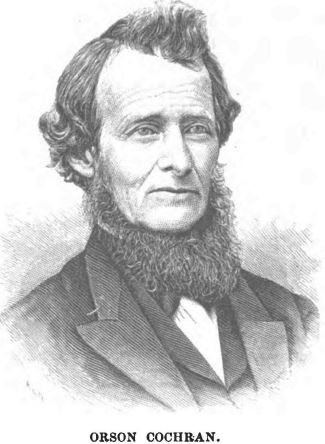Otto
| 284 | HISTORY OF CATTARAUGUS COUNTY, NEW YORK |
|
This is the third town from the west line of the county, upon the northern border. The towns of Mansfield and New Albion form its southern boundary, and East Otto joins it upon the east. On the north, against Erie County, the boundary is defined by the waters of Cattaraugus Creek, flowing westward to Lake Erie. The south branch of the same creek enters the town near the southeast corner, and flowing thence towards the southwest, passes across Otto and enters New Albion, but soon returns by a sharp bend to the northward, and flows in that general direction, upon the boundary between Otto and Persia, to its junction with the main Cattaraugus. These streams enclose the town as a peninsula, and by them and their small tributaries it is watered abundantly. At their confluence, in the extreme northwestern corner of Otto, is a high and rugged promontory, the most elevated land in the town. For several miles above this point the banks of both streams continue high and precipitous, rising in some places to the height of 300 feet. These rugged bluffs along the main creek have received the local designation of " the breakers;" and the narrow gorge through which the stream flows (contracted at one point to a width of about 350 feet) is usually known as "the narrows." Farther back from the streams these highlands subside into undulations and hills of moderate height. Towards the northeast part of the town " the breakers" terminate, and the banks of the Cattaraugus spread out into a river bottom land covering about 300 acres in Otto, extending thence into the adjoining town, and known as "the Valley of Zoar." EARLY SETTLEMENTS.The locality known as the Valley of Zoar, containing from 800 to 1000 acres of bottom lands, is situated along both sides of Cattaraugus Creek, and in the southwest part of the town of Collins, the northeast part of the town of Otto, and the northwest corner of East Otto. Attracted by its excellence and great fertility, settlers as early as 1811, following up Indian trails, stopped on these rich alluvial lands and located. First among these were Joseph Adams and his son Blinn, from Madison County, who located on lot No. 20, township 6, range 7, in this town, where Mrs. George Kelly now resides. He lived there four or five years and moved to Cincinnati. Settlers by the names of Hyde and Austin came in about the same time and located near them ; they, too, remained a few years and moved West. In· the spring of 1812, Peter Pratt, with his wife and ten children, from Clarence, Erie Co., settled in the Valley of Zoar, on the north side of the creek, in the town of Collins. His sons afterward were identified with the early settlement of East Otto. Joseph Bartlett in 1813 emigrated from Canada |
with his wife and children to this town, and located on lot 24, township 6, range 7, in the valley where Alexander Ingraham now resides, and built a log house, where be lived until between the years 1819 and 1823. He then bought a farm on the north side of the creek, where he moved, and bis children grew up to manhood and womanhood, married, and moved away. A few years aft.er settling here he felt impelled to preach the gospel ; and, encouraged by Christian friends, he decided to enter the ministry of the Christian denomination. In accordance with this decision, and a willingness on the part of those in authority in that church, an ordination meeting was held at his house, three ministers of that denomination being present. After examination he was accepted, ordained, and for many years preached in all parts of the country round about,-at the school-house on the bluff at Collins, at Davis Benedict's house in North Otto, and in many other places, receiving corn for his compensation. In those days subscriptions were made by persons seeking to pay a certain number of bushels of corn. No church of that denomination was ever organized in the town, but the Rev. Joseph Bartlett had the honor of being the first standard-bearer of religious truth in the early days of Otto. He afterwards removed to the West, where he died at an advanced age. Phineas Orr, a single man, came in from New Hampshire in the spring of 1813, located on lot 1, township 6, range 81 where Mrs. Eddy now lives, and built a log house; and in the spring following moved across the creek and settled, afterwards marrying Hope, the daughter of Peter Pratt. They lived there many years, and are both buried in the cemetery at East Otto. He was a general in the State militia. Samuel Hill, a native of New Hampshire, emigrated to Canada East, and from there to this town, in the Valley of Zoar, coming down the creek in a canoe with his family, consisting of his wife and three sons, Jehiel, Asahel, Joseph, and two daughters. The number of families in the settlement at this time, including Mr. Hills, was four. They arrived April 12, 1814, and moved into the log house built by Mr. Orr, buying one hundred acres where Widow Bruce now lives. The next year, 1815, Mr. Hill bought a farm on the north side of the creek, in the town of Collins, and built a log tavern. Cattaraugus Creek now runs over the spot where it stood, the bank where it stood having been washed away by the current. The floor of the tavern was of black ·walnut, between two and three feet wide, rived, and one ·side faced with a broad-axe. Potatoes, johnny-cake, venison, and bears' meat were the principal food. The next day aft.er opening the tavern nine land-lookers stopped |
|
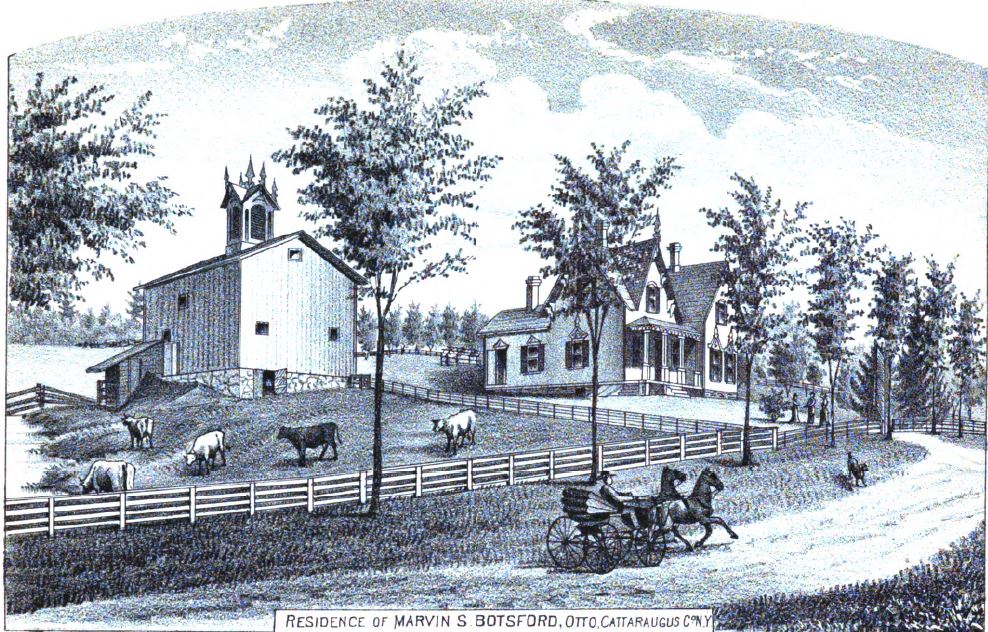 |
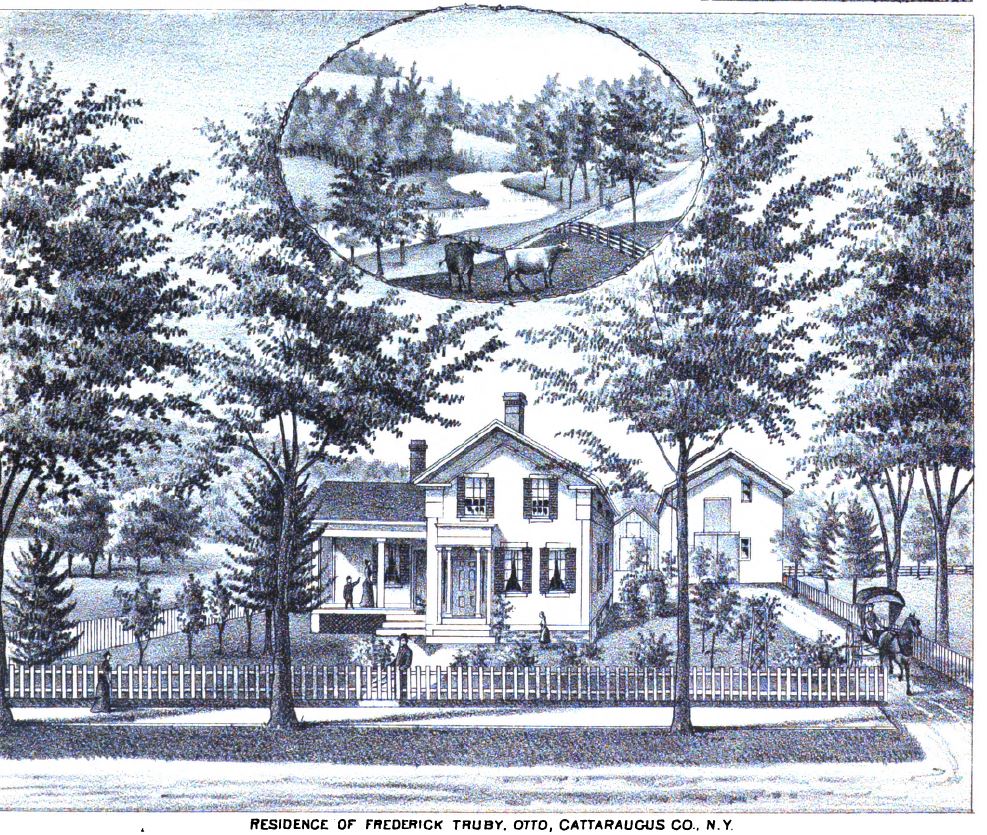 |
| HISTORY OF CATTARAUGUS COUNTY, NEW YORK |
285 |
|
there, and stayed all night, sleeping on the floor. For thirty years Mr. Hill, as "mine host," offered entertainmnt to man and beast. Jehiel Hill, the oldest son, was a man of noble and commanding presence, of considerable political influence in the ranks of the Whig party in Erie County ; was captain . of the State militia ; promoted to colonel of the 19th Regiment, and then to general. He was at one time postmaster. In 1824 his name appears on the assessment-roll of Otto as owning land on lot 16, township 5, range 8. Asahel Hill also is recorded as on lot 1, township 6, range 8. He was adjutant of the 19th Regiment, and justice of the peace in 1827. Joseph, the younger brother, now living in the north part of the town, was fifer in one of the companies. Stephen Williams, from Danby, Rutland Co., Vt., emigrated to Concord, Erie Co., in 1816, with his wife and fourteen children, and settled in Zoar, on the north side of the creek. About this time David, his eldest son, settled on this side of the creek, in what is now East Otto, on lot 18, township 6, range 7. In 1824, the name of Stephen Williams appears on the assessment-roll of this town and East Otto as owning land on lots 18, 10, and 20, township 6, range 7. He bought a large tract, since known as the " Williams Tract," including the land where Adams, Hyde, and Austin, the earliest settlers, located. He was a thrifty farmer, interested in the raising of cattle, often wintering from fifty to one hundred head, and was a man of considerable wealth. Isaac, Benjamin, and Stephen Ball~rd, three brothers, left Vermont on foot, in 1818, each with a knapsack on his back with provisions for their journey. After reaching this town in the spring, Benjamin took a contract of chopping 5 acres of land at $5 per acre, of Asahel Nye, who lived on lot 54, township 6, range 7, now in the town of Ashford. Stephen hired out to John Williams, of Concord, for the haying season. Isaac remained with Benjamin, and after Stephen finished the haying, he assisted his brothers. The contract was finished about the let of September, when they went to Collins and took another contract, which they finished about the last of November. About the 1st of December they came into this town, when the brothers took up about 360 acres on lot 4, township 5, range 8. They built a shanty of logs, about 8 feet high on one side, and 6 feet on the other, and roofed it with elm-bark, smooth side down, held down by• poles withed fast to the rafters. Isaac lived with Benjamin as a bachelor all his days, and died in 1868. Benjamin married the daughter of Nathaniel Ballard, Oct. 5, 1824. He is still living, and resides in the village of Waverly. His son, George W. Ballard, lives on the old homestead. Stephen lived in town until 1850, when he moved to Erie Connty, and from there to Wisconsin. Ira Waterman came from Cortland County, and located on lot 1, township 6, range 8, before 1819. He was an assessor, commissioner of schools, and commissioner of highways in 1823. He afterwards moved to Gowanda. He was a brother of Simeon Waterman, who lived west of Waverly in 1824, and had there an ashery. Ephraim Brown, also from Cortland County, was here in the fall of 1818, before the Ballard brothers, and settled |
on lot 5, township 5, range 8, with his wife and three children, built a log house, and to them was born, in 1819, a daughter Lavina, the first white child in town. The first t-0wn-meeting was held at his house, also the first wedding, being that of Bryant Benson and ~Ire. Ballard, the mother of the Ballard brothers. The ceremony was performed by Squire Abel M. Butler. In 1816, a contract was issued by the Holland Land Company to Barnard and Chester Cook. William Cook and Mason Hicks located in Zoar early in 1819, Cook locating on lot 21, township 6, range 7, where William Ingraham resides, and Hicks on lot 23. John Pratt, a son of Peter Pratt, married Lavina, daughter of William Cook, Oct. 5, 1823. Iu 1824, William Cook owned land on lot 21, township 6, range 7, Esek Cook on the same lot, and Silas Cook on lot 20, and Mason Hicks on lot 5, township 6, range 7, in East Otto. Adam Ballard, from Otsego County, settled in the town in 1819, taking up land on lot 5, township 5, range 8, where his grandson, Truman Ballard, now lives. Isaac Skinner settled on lots 28 and 29, in the winter of 1819-20, having contracted for the land in 1816, at what was afterwards known as Skinner Hollow, on the bottom lands at the head of the " breakers" on the south branch of Cattaraugus Creek. D. P. Skinner was postmaster at this place as early as 1825, and probably the first in the town. A saw-mill was erected at this place, on the creek, about 1823. Joseph Allen, brother of Judge Allen, of Gowanda, came into the town in 1819, the year after the road was opened by the Holland Land Company from Ellicottville to Hidi. He followed an Indian trail up the creek to lot 58, township 5, range 7, now owned by his nephew, C. B. Allen. Mrs. Joseph Allen was the first person who died in the town. He was supervisor in 1830, and a justice of the peace. Mrs. Sykes, of Mansfield, is his daughter. His death occurred Dec. 12, 1867, at eighty-six years of age. Mrs. Allen (2d) died July 30, 1873, at eighty-seven years. Benjamin Austin, a soldier of the war of 1812, and a native of Hartford, Washington Co., in the fall of 1820 emigrated with his wife and seven boys to this town, and located 150 acres on lot 7, township 5, range 8, coming through Attica, and Aurora to Springville, and through the Valley of Zoar to this place. Edward W. Austin, one of his sons, taught school in a log house on lot 14, on a farm he had taken up. Jacob Austin, a son, lives on the old homestead. Joseph and Wadsworth Foster, from Hartford, Washington Co., came to Collins in the spring of 1817, and remained that season. In the spring of the next year they came over to this town and located on lots 6 and 7, township 5, range 8, where Albert Foster now lives. They cleared off a piece of land and put in some wheat; built a shanty of poles, making the floor and roof of basswood bark; that of the floor being held flat by pins and the roof by poles. The sun curled the bark on the roof, so that in times of rain it afforded but little protection. They recovered the roof with elm-bark, which made the shelter much better. In the fall, while working in the clearing, |
|
| 286 | HISTORY OF CATTARAUGUS COUNTY, NEW YORK |
|
their shanty accidentally caught fire, and the provision, clothing, and what little furniture they had, were totally destroyed. They returned to Collins in the winter, where Joseph taught school not far from where Edward Foster now lives. In 1819 they came to their lot, and built a log house north of Albert Foster's present residence. Joseph married Hester Wheeler, a sister of Mrs. Benjamin Austin, who lived near them, Abel M. Butler performing the marriage rite. Joseph Foster was a constituent member of the Methodist Episcopal Church in the north part of the town. He was with Samuel Tuthill, the first inspector of common schools and justice of the peace. His death occurred in December, 1874, aged seventy-five years. Wadsworth Foster settled near his brother, and is still living, and resides with his son, Almon Foster, on lot 2, township 5, range 8.
John Beverly, with his wife and children, came from Truxton, Cortland Co., in the year 1820, and located 150 acres on lot 23, township 5, range 8, having contracted for land of the Land Company in 1816. John, his son, lives in Waverly; James, another son, lives on lot 16, in the north part of the town. Austin Pratt, who had located on lot 45, township 6, range 7, married Maria, daughter of John Beverly, Elder Joseph Bartlett officiating in the services. . In 1824, John, David, and Thomas Beverly were located on lot 24, and John and James C. Beverly owned lands on lot 3, township 5, range 8, and David Beverly on lot 14, township 5, range 8.
In 1816 a contract was issued by the Holland Land Company to Abel M. Butler. Afterwards Abel M. and Harvey Butler came from Oswego County in 1820, and located on lot 22, township 5, range 8 ; locating at the same time 100 acres on lot 23, township 5, range 8, for his brother.in-law,
Hugh McKinney, who came in the next year. Abel came with his wife and child, built a log house, and moved in. Harvey lived with him. The latter, after preparing a home, returned to Oswego County, and was married. Abel M. Butler was the first supervisor of the town upon its erection in 1823 (re-elected in 1824), and the first justice of the peace of the town, a position he held for several years. In his later years he removed to Harmony, Chautauqua Co., and died in December, 1872, at the age of eighty-one years. His son James lives in Waverly.
Luther Town came in from Madison County to Erie, and to this town in 1821 with his wife and children. He settled 100 acres on lot 5, township 5, range 8, where Samuel Charlesworth lives. He was one of the first assessors of the town. His son George lives in Little Valley. Oliver Tripp located on lots 49 and 50, where F. Bernhoff resides, on the farm of N. Loomis.
Davis Benedict, from Penfield, Monroe Co., came in the year 1822, and settled on part of lot l3, township 5, range 8, where Charles Stebbins now lives. Religious services were often held at his house, conducted by the Rev. Joseph Bartlett. The first burial-place in town was upon his farm, and is still in use.
C. B. Parkinson, of Springville, in 1821 selected a millsite
|
on lot 1, township 5, range 8, on the north side of the south branch of Cattaraugus Creek, near the old bridge, and built the first saw-mill (Jacob Van Aernam and his sons, Abram and Nathaniel, building the dam) and first frame building in the town. It was raised Oct. 2, 1822. Benjamin and Stephen Ballard, John and Thomas Beverly, the Hill brothers, from Zoar, Ephraim Brown, Jacob B. Van Aernem and his sons, and Elder Bartlett were at the raising, which was not completed till the following day.
Shedrick Herrick and Edwin Farnsworth in 1822 settled on lot 66, on or near the place now owned by Dr. Goldsborough. Herrick soon after coming in had a son born, who was the first male child born in town. Farnsworth erected the first frame dwelling in town, on the farm afterwards sold to Sylvanus Parkinson.
Otis and Peter Guile, from Vermont, located land on lot 4, township 5, range 8, before 1823; and Otis also on lot 69, township 5, range 7, in the town of East Otto. Moses Boone, from Onondaga County, located on lot 8, township 5, range 8. Alpheus Hnrwood, from near Canandaigua, on lots 22 and 30, township 5, range 8. Henry Willets, from Scipio, located land on lots 10, 18, and 21, township 5, range 8, about the same time.
Alexander Little, with his wife and five sons, came from Madison County in the fall of 1822, remaining over night at Hill's tavern in Zoar, arriving in the town Oct. 2, 1822. He purchased a chance of 100 acres on lot 15, township 5, range 8, of a man by the name of McNeal, who had located about a year previous, having bought of the Land Company at $1.50 per acre, erected a shanty and made a little slashing. Little was a blacksmith; he brought his tools with him. He erected a log shop that fall and commenced work. This was the first blacksmith-shop in town. The first barrel of salt that was brought in town Mr. Little bought in Syracuse, on their way to this place, and paid for it $1. They also brought a little flour with them. After getting out, they bought of David Beverly (who lived on lot 14, township 5, range 8, a little south of them) two bushels of wheat, for which they paid $1, and carried it to Lawton's mill, in the town of Collins, near Kerr's Corners, to get it ground. Thomas Little now lives in the village of Waverly. His son is living on lot 16. Harvey Little lives at Gowanda, and owns a farm on "Forty," as it is called. In the fall of 1823, Edwin Putney, a young physician, came in from Livingston County, and boarded during the winter with Alexander Little, practicing his profession until the following spring, when he left the town.
Alvin Plumb, familiarly called " Lord Plumb," in 1824 located on lot 9, township 5, range 8, afterwards called the Lower Village; built a log house and a blacksmith-shop; put up a water- wheel on the creek to run a spinning-wheel ; manufactured cow-bells for the farmers throughout a large extent of country. In 1827 he removed to Hidi.
Mary Price, a spinster from near Pittsburgh, Pa., came in alone in 1824, and bought 50 acres of land of Abel M. Butler; hired two acres chopped, made a logging-bee, and had the logs rolled up for her house by the neighbors. When the road tax was to be collected she refused to pay it, but went out and held the scraper, and paid her road tax as the men did. She was not in much favor, and was
|
|
| HISTORY OF CATTARAUGUS COUNTY, NEW YORK |
287 |
|
the butt of the community. She lived there many years, and finally died in the poor-house at Machias. Stephen Rogers came to the town in 1824, and bought land where Waverly now stands; and in 1825 bought the saw-mill of C. B. Parkinson. In the fall of 1826 he erected · the first grist-mill in the town and the first tavern, raising them at the same time, the neighbors gathering at the ra1smg. Among these were Thomas and Harvey Little, Darius Warner, Square Travis, the Austins, Fosters, Greens, Butlers, and Barbers. Whiskey passed freely, and two days were occupied in completing the raising. He had a log house where Mr. Wm. F. Elliot's bank now stands, and in 1826 Sydney Stearns taught school there. In 1827 he sold the hotel to David Elliot, who kept it many years. Mr. Rogers soon after sold his property in the town and removed to Dunkirk. James Barber settled on lot 12 in 1823, where his son, James M. Barber, now lives. Robert McDuffie, a native of New Jersey, resided in Montgomery County, and for a period of six years followed teaming from Albany to Buffalo. In 1823 he came to this town, and located on lot 3, township 5, range 8, where Hoyt Hinmam owns; lived there a bachelor for about three years, married Eliza Eldridge, and moved on the west side of the creek at Waverly ; afterwards bought a half interest in the carding and cloth-dressing mill of R. Knowlton, which he retained a few years. His death occurred in 1871, at the age of seventy-seven years. His son lives at Waverly. Simeon Waterman, a brother of Ira Waterman, came here in 1823, and bought a chance of 15 acres of Edwin Farnsworth, on the hill north of Waverly. He built the first ashery in town, and a log house where Martin Botsford now lives. In November, 1824, Vine Plumb, from East Otto, bought Waterman's chance, the ashery and house, put in some goods and opened the first store in the town. The winter was very open, and a good time for the farmers to make ashes and black salts, and Plumb manufactured during the winter fifty barrels of pearlash, which be sent to his brother in Gowanda, with whom he was connected. He remained at this place about two years, and sold the place to Sylvanus Parkinson, who bought 170 acres of Edwin Farnsworth, including his. He then removed to Waverly, contracted land of Stephen Rogers, and erected the first frame house in Waverly for a dwelling and store, where Wolff's grocery now stands. He married Caroline Stebbins, of East Otto, in 1826, Squire Samuel Tuthill officiating on the occasion. He was born in Paris, Oneida Co., Jan. 4, 1798; emigrated with his brother Ralph to Gowanda in 1823, where Ralph went into business and lived many years. In June, 1824, Vine Plumb took a stock of goods to half a mile cast of East Otto and opened the first store in what is now that town, and remained until November of that year, when he removed to this town, where he still resides. He was town clerk from 1826 to 1837. Daniel Botsford, a native of Middletown, Conn., came to this town in 1824, and settled on lot 6, township 5, range 8, buying 150 acres. He afterwards bought the farm of |
Ephraim Brown, where he located and lived many years. He was the leader of the first Methodist class organized in the town. Ephraim Green lived in Wayne County, and in 1823 came to this town and located land for his sons, Nathan and James C., on lots 23 and 24, township 5, range 8, who came in 1824. Nelson [sic] built a log house on lot 23 in the fall of 1825, and married in the spring of 1826. He afterwards bought a farm on lot 31, and lived there many years, and moved to Michigan. He represented the town as supervisor from 1832 to 1835 and from 1839 to 1844. James C. Green came in at the same time with his brother, and in 1826 worked part of the lot his father selected. In 1830 be settled on 250 acres on lot 24, township 5, range 8, and married Maria, daughter of DavidMcMasters, who came in from Montgomery County in 1826, and settled 168 acres on lot 4, township 6, range 8, where his son, W. G. McMasters, now resides. David and Wm. Blaisdell, in 1823, settled on lot 57; David on the farm where Frank Harvey now resides, in the southeast part of the town. John Ferris, Matthew Parkinson, John Cotrael, and John C. Cross came in town between 1824 and 1826. Ferris, from Schoharie County, settled on lot 65, township 5, range 7, where James, bis son, now lives. John T. Ferris, his cousin, came in a year or two later,· and settled in the north part of the town, on lot 69, township 5, range 7, where Wiley Botsford resides. He was supervisor of the town in 1829-30. John Cotrael emigrated from Schoharie County in 1826, with a team of horses, harness, and sleigh that the father and father-in-law of John Ferris wished to send out to him as a present. Mr. Cotrael located on lot 65, buying 200 acres, 100 acres of which were for John C. Cross, who settled in 1828. The sons of Mr. Cotrael are living in Waverly, where they are engaged in the hardware business. He is still living on the place he originally settled. Dexter Bartlett, a native of Vermont, came to this town, with a wife and seven children, in November, 1825, traveling by canal from Troy to Buffalo, from thence by team to lot 6, township 5, range 8, where he settled upon 100 acres, building a plank house on the farm Wm. Bull now owns. His son Nelson lives in Waverly. Champlain Babcock settled on lot 2, township 6, range 8, in 1826, where his family still reside. Caleb Lewis, from Washington County, settled, in 1825, on lot 7, where his log house still stands, across the street from the Methodist church. Bela Tarbox, Russell D. Gibson, and Hosea Merrithew settled on lot 51, in 1823-24. Isaiah Tarbox, brother of Bela, came in from Oneida County, with an axe on his shoulder, a clean shirt, ten cents in money, and an article for 50 acres on the same lot, and slept on the " breakers" in a hollow log when coming from Springville. He built a log house where his daughter, Mrs. Lansing Edwards, now lives. Hosea Merrithew lived near him. They put out apple orchards on their farms that are still standing. in the first year his grist |
|
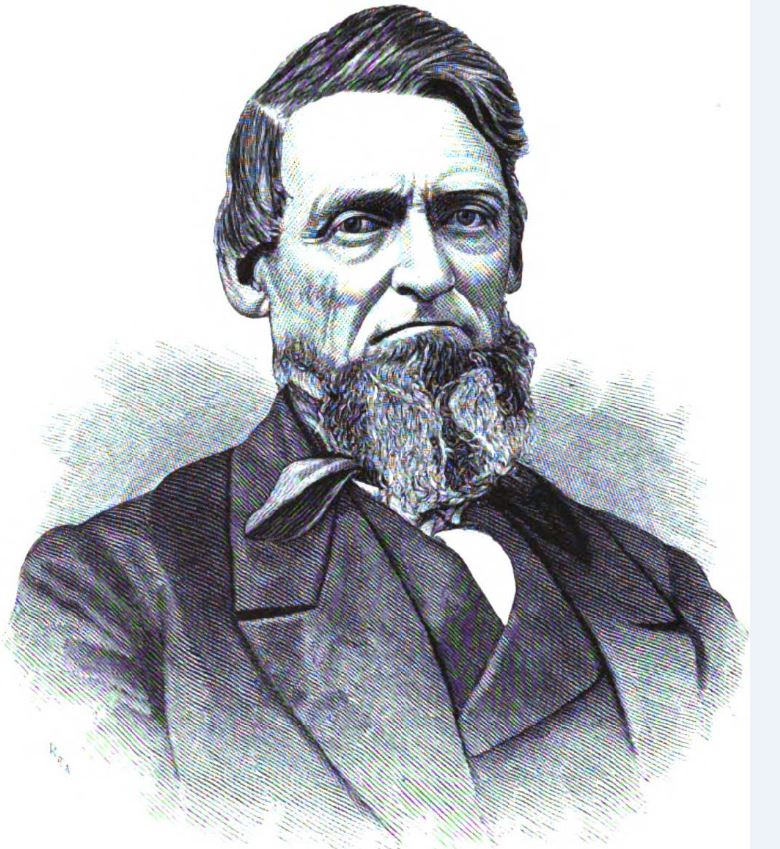 |
SYLVESTER M. COX
|
Sylvester M. Cox was born in the town of Camillus (now Elbridge), Onondaga Co., N. Y., July 7, 1807. His parents, Edward and Abigail (Mann) Cox, moved from Derry, Windham Co., Vt., to Onondaga County in an early day (in 1807), there locating on a farm. In 1824, Edward Cox made a journey to the West, prospecting, and four years later removed with his family to Cattaraugus County. His son Sylvester, however, preceded him, settling in the town of Otto, near Waverly, March 4, 1825. Sylvester’s mother was a native of New Hampshire. She died in 1858, at Niles, Mich., to which place the family removed in the fall of 1845. After her death, her husband, father of our subject, returned to Otto, where he died in April, 1860, at the residence of his son. Of their family of thirteen children. nine lived to adult age and married, but only two now reside in this county,——Sylvester M. and Emily Angeline, who is the wife of Pherson Ward, of Great Valley. The others are widely scattered, residing in Illinois, Iowa, California, and other States of the Union; and one died in Michigan, in 1876. Nearly all of the sons were farmers. Mr. Cox's early life was spent in farming. He helped to clear up the land, and assisted in cutting the roads of that vicinity. There were then no barns, and the houses were but shanties covered with basswood logs. When he came to Otto its population was small and scattered. He well remembers the first town-meeting he attended in the town, then a large district compared with its present area. It was in 1825, and he does not think there were fifty voters in the town, although at that meeting about five hundred votes were cast. The ballots were deposited in hats in lieu of ballot boxes, and as the inspectors of the election were not very well posted as to their duties and the requirements of the law, they allowed each person present, young and old, to not |
only vote, but to vote as often as they pleased, one young man of seventeen insisting on a vote for each year of his age ! But those were primitive days. He had few opportunities for procuring an education, most of his knowledge having been acquired by self-culture since the days of his boyhood. Besides working at farming, in the earlier portion of his life he was engaged in blacksmithing, and for a time worked as a moulder in a foundry; but the pursuit of agriculture has mainly engaged the attention of his life. He owns a number of farms in this county, and one in the town of Concord, Erie Co. For many years he resided in New Albion, but after the death of his youngest daughter he took up his abode with his father-in-law, Judge Scott, at Ellicottville; but he still claims a residence in the former town, and expects to end his days there. In 1830 he married Reliance Schoharie, a native of Carlisle, Schoharie Co., N. Y., and whose parents came to Otto in 1829. Of the issue of this marriage, four children, only one survives,-—Sarah M., who married Charles F. Derby, and lives in the town of Persia. Cornelius died in 1860, Melissa in 1836, and Vida, wife of Judge Allen D. Scott, in the winter of 1877. Mr. Cox was bereft of his companion in December, 1865, and subsequently married Desire Little, who was born in Onondaga Co., N. Y., in January, 1821. Mr. Cox has held several minor town offices both in Otto and New Albion. In the former he was assessor before the town was divided, and held the office for ten or more years. He also represented the latter town in the board of super visors. His political action has been with the Whig and Republican parties, and his religious preferences are with the Congregational Church, of which he is a member. He never had but one spell of sickness in his life, and now, in his seventy-first year, and in the enjoyment of good health and a competency, can review a well-spent life. |
|
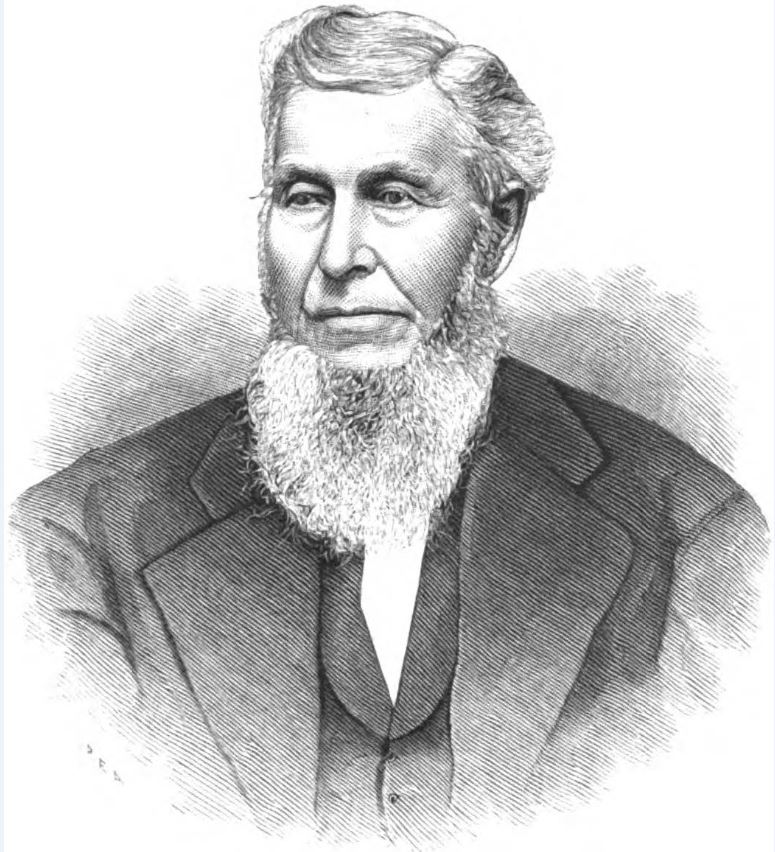 |
JUSTIS SCOTT
|
In the history of the town of Danby, Vt., published in the year 1869, I find as follows:
Justus Scott, one of the seven sons above mentioned, now lives in the town of Otto, in this county, on the farm to which he moved in the year 1831. He was born in the town of Wallingford, Vt., on the 19th day of March, 1799. Soon after his birth bis family removed to Danby, Vt., where Justus remained with them until the year 1816. The father was poor, and the family had already become accustomed to hard work ; and each had acquired the habit of providing in a large measure for his own wants. Facilities for an education in those days were few, and this family were unable to avail themselves of such as then existed. Two months, after he was twelve years old, was all that Justus had. And when he was seventeen years old he and his elder brother-Phineas-left home on foot, with packs on their backs, to seek their fortunes in " the far West." They traveled sixteen days, and arrived at Springville, in the county of Erie, in October, 1816. Chopping by the job was the first business engaged in. They cooked their food, and kept " bachelors' hall" in the woods. Justus soon took an article of a piece of land on the road from Springville to Ashford, about one mile south of Springville, and in July, 1817, married Emily Hardy. They commenced housekeeping strictly in accordance with the plan of the pioneer settlers; the body of a fallen tree for the rear of the house, crotches for the front pillars, covered with basswood "dug-outs," and the ground for a floor. Here the husband and wife lived a few weeks until a commodious log house could be built. Three children were born to them while in this place near Springville: Just.us J. Scott, May 14, 1818, who became a thrifty farmer, and now resides at Cattaraugus Station, on the Erie Railroad, in the town of New Albion. John H. Scott, June 12, 1820, who enlisted in the army of the late Rebellion, and died Oct. 22, 1863, of disease of the heart. |
Mary E. Scott, Feb. 15, 1824, and died Jan. 15, 1826. His family experienced the usual hardships and privations of pioneer life, and on the 7th day of August, 1828, the household was broken up by the death of the wife, the father and the two boys getting on the best they could. Mr. Scott, about this time, became the owner of a span of horses,-a luxury for those days,-and these horses strayed into Cattaraugus County, which was then called the South Woods. There being no roads, Mr. Scott tracked them to what was known as the McCluer settlement (now the village of Franklinville), and found them near Olean Point, fifty or sixty miles from home. Mr. Scott was married to Selecta A. Darling, March 4, 1830, at Springville. Mrs. Scott was the daughter of Rufus and Pruda Darling, who came into East Otto in 1825, and settled near Capt. Beach's grist-mill. She is the sister of the Hon. John P. Darling:, now residing at Cattaraugus Station, and Rufus P. Darling, late of Monroe County, deceased. Allen D. Scott, the eldest of Mrs. Scott's children, was born at Springville, Jan. 15, 1831, now county judge of Cattaraugus County. Selecta A., now the wife of Dr. A. L. Dudley, of East Otto, was born in Otto, Feb. 18, 1833. Clark W., now a farmer residing in East Otto, was born Jan. 15, 1835. Apoline P., now the wife of Luther B. Allison, was born March 3O, 1837. Winfield L., now United States postal clerk on the Buffalo and Jamestown Railroad, was born Dec. 1, 1842. Walter G. Scott, now station agent at Ashford, on the Rochester and State Line Railroad, was born Sept. 15, 1850. Lou Eda, now the wife of Chauncy W. Strickland, was born March 10, 1855. In March, 1831, he bought the interest of Russell D. Gibson in sixty acres of land in the east part of the town of Otto, and by the untiring energy of himself and family cleared off and paid for the land, and purchased more until he became the possessor of five hundred acres of well cultivated land. Here he remained until 1848. when be removed to Springville, the better to give his children facilities for an education, and in 1853 returned to the farm, where he still resides. Mr. and Mrs. Scott early joined the Methodist Episcopal Church, and have ever lived consistent Christian lives, respected by their neighbors, and loved and honored by their children. |
|
| 288 |
HISTORY OF CATTARAUGUS COUNTY, NEW YORK |
|
|
Sylvester M. Cox emigrated from Onondaga County when about eighteen years of age, arrived in this town the 4th of March, 1825, and was employed by Alexander Little, with whom he remained about two and a half years, working at clearing land and blacksmithing; the first year he was in town he assisted in building 35 buildings,dwellings, barns, and school-houses. Before he was of age he took a contract of John T. Ferris for clearing 45 acres. In 1828 he bought a chance of 100 acres of Thomas Beverly on lot 1, township 6, range 8, but soon traded for a larger farm on lot 7, township 4, range 8, in New Albion, with Vine Plumb. On the 25th of April, 1830, he married Reliance Slaght, and in the fall of that year commenced housekeeping, and remained there five years, and moved to Waverly, where he worked at blacksmithing for one and a half years. In the spring of 1837 be traded his house and lot and shop and some land he owned in Michigan tor a part of the farm he formerly owned in this town, and moved upon it and remained until 1866. He was the father of four children. Mrs. Judge A. D. Scott, of Waverly, now deceased, and Mrs. Chas. F. Derby, of Gowanda, were his daughters. He now resides in Ellicottville. James Borden, from Schoharie County, came to Waverly in 1826, with his wife and two children, and settled on lot 1 in the village of Waverly. He was a tanner by trade, and in the first season built vats in the yard in the rear of his house. In the spring and summer of 1827 he built a tannery across the brook from his house. It remained in possession of the family until February, 1872, and was destroyed by fire in October following. Mrs. Borden is living at Waverly. W. H. Strickland married their daughter for his second wife. Sons and daughters are living in the town. Livingston and William Cross came to the village of Waverly in 1827 ; the former was a carpenter and worked upon the grist-mill and tavern of Mr. Rogers, and still resides in the village. The latter tended the grist-mill. Peter Karker was here in 1827, and assisted in setting the machinery in the grist-mill in June, 1827. He was one of the constituent members of the Presbyterian Church. Bliss Loomis emigrated from Bennington, Vermont, to this town in the winter of 1826-27 with his wife, and passed the winter at Waverly. Mrs. Loomis made the bolt for the mill, which was the first used in the vicinity. In the spring of 1828 he located about two miles east of Waverly on lots 49 and 50, and built a log house on the spot where his son's barn now stands. They had two sons, Henry C. and Nelson. Henry C. went out in the war of the Rebellion as lieutenant in the 64tb Regiment and afterwards joined the 154th, of which regiment he became colonel. He now resides in Kansas. Nelson, and Charles O'Brien, of Waverly, were the first two to enlist in the town on the call for troops in 1861, the latter being the first. Nelson is living on the old homestead. Justus Scott came from Springville to the town of Otto, in March, 1843 He bought a part of lot No. 50, the interest of Russell D. Gibson, in 60 acres of land, held by contract, where the farm buildings now stand. Mr. Gibson, in 1824, had two pieces of land on lot No. 51. Adjoining them were four or five acres cleared, and as much more slashed. The old framed house now used as a tenant |
house was enclosed and roof on, and the frame of the old barn was up. Mr. Scott and the two older boys commenced chopping and clearing and buying more land until he became the owner of about 500 acres of land,-one of the finest and most productive farms in the county, and more than half of which has been reduced from a wilderness to productive, well-cultivated land by his untiring energy, assisted by his sons. An incident occurred in 1838 worthy of mention. Mr. Scott had slashed about 10 acres, intending to burn and clear it off for a crop, but was compelled to be away from home about a week at a time when it should have been burned. Mrs. Scott waited a day or two for his return, but finally concluded to set the fires herself. The trees had been felled in windrows, and she took the torch, and as she entered the slashing commenced setting the fires, passing on and on with her torch, touching the dry leaves here and there until there was a streak of flame around nearly the whole piece, and she inside, apparently with no way of escape. In the excitement she had neglected to attend to her own safety. Greatly frightened and fully appreciating her danger, she reflected a moment and then ran to the place she entered, where she found a space between the end of the windrows, where she passed out, nearly exhausted with the heat and smoke. This is an instance illustrating the energy and spirit that actuated the wives of the early settlers of this county. In 1845, Mr. Scott borrowed $500 at the bank, and purchased a dairy of 50 cows. They cost him in March of that year $12.64 each when he got them home. He hired one of the Austins, of Hamburg, to teach the family how to make cheese, and that year he sold his cheese to Ralph and Joseph Plumb, of Gowanda, for five cents a pound, and delivered the same in Buffalo, and with the proceeds paid his bank-note, and had more money to pay on his land than he had ever been able to pay in any previous year. He urged the Plumbs to contract his cheese for five years at five cents per pound, which they declined. He never sold so cheap afterwards. In 1848 be rented his farm with 50 cows to Noah Starr for five years, at $500 a year, and removed with his family to Springville, to enable his children to attend the academy. In 1853 he retired with his family to the old farm in Otto, where he now lives. Rosewell Knowlton, in 1829, built a custom-mill, and set up a carding-machine on the creek about one-half mile below Waverly, where the Pearce Woolen-Mills now stand. In the next year he sold a half-interest to Robert McDuffie. H. W. Ingraham, of Rensselaer County, a soldier of the war of 1812,settled where his son Simeon now lives. Alexander lives at Zoar. David Elliott, in 1827, bought of Stephen Rogers the tavern property in Waverly, and kept tavern for many years. Selleck St. John, a son-in-law of Mr. Elliott, was the first postmaster in Waverly, in 1830, and afterwards justice of the peace. W. F. Elliott, in 1831, opened a store in the village of Waverly, where Truby's clothing-store now is, and dealt largely in black salts, for which cash was paid at the average rate of $2.50 per hundred, and manufactured pearlash. The ashery was situated below R. Dewey's foundry. He is still living in the village, and is proprietor of a private bank. |
|
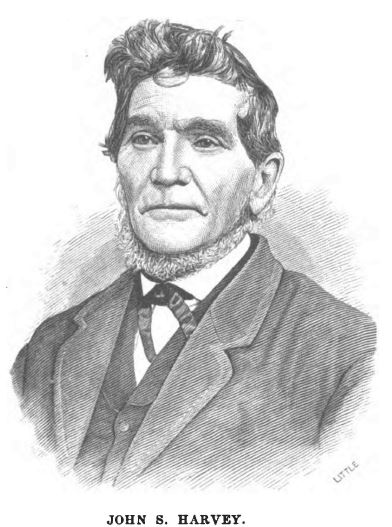 |
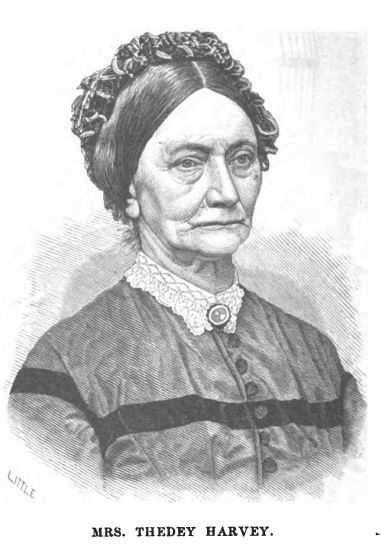 |
|
One of the largest landed proprietors, and a prominent citizen, universally esteemed and respected, resident of this town, was he of whom we write. Mr. John S. Harvey was born in the town of Marcellus, County of Onondaga, State of New York, in June, 1805. He emigrated to Cattaraugus County, February 11, 1827, and first settled in that portion of Little Valley now known as New Albion. Before leaving Onondaga County, however, he married (in 1827) Miss Thedey Reed, who was born in 1805. Jonathan Reed, father of Mrs. Harvey, was a native of Massachusetts, of Puritan stock, and a descendant of Revolutionary sires illustrious in the annals of our country's history, He was born before the struggle for Independence (in 1774), and during the administration of our second President (in 1798) moved westward to New York State, taking up his pioneer res"idence in Onondaga County, which at that date was an unsettled wilderness. He followed farming all his life, and died in 1829, aged 55 years. Medad Harvey, father of our subject, became a resident of Onondaga County, New York, about the year 1800. He purchased and settled upon a farm in the town of Marcellus, where his son, John S., was born, passed his youth, obtained his education, and "followed the plow" until he attained his twentysecond year, when he married and moved west to |
make himself a home in Western New York, as previously mentioned. The family of Mr. J. S. Harvey numbers three sons,-Hiram R., Alfred B., and Frank J. Harvey,-all of whom are living: Hiram, in Cattaraugus village; Alfred, in the village of Randolph, this county; and F. J., about a mile from Waverly, in the town of Otto. John S. Harvey was the owner of six hundred and twenty-five acres of land in Cattaraugus County. Politically, Mr. Harvey acted with the Democratic party, at whose hands !1e received several offices of honor and trust, among others that of supervisor of the town of New Albion. He was an active member of the Baptist denomination, and contributed liberally to the support of that society. He died February 1, 1871, aged sixty-six years. His remains repose in the cemehiry at Waverly. His widow still survives at the age of seventy-three, quite hale and hearty for a person of her years. The original homestead is now owned by his second son, Alfred B. Harvey. To the memory of his parents, Frank J. Harvey* has caused their portraits to be here inserted, in connection with the record of their lives, and thus handed down to future generations. *A fine view of F. J. Harvey's residence, and portraits of himself and wife, may also be seen in this work. |
|
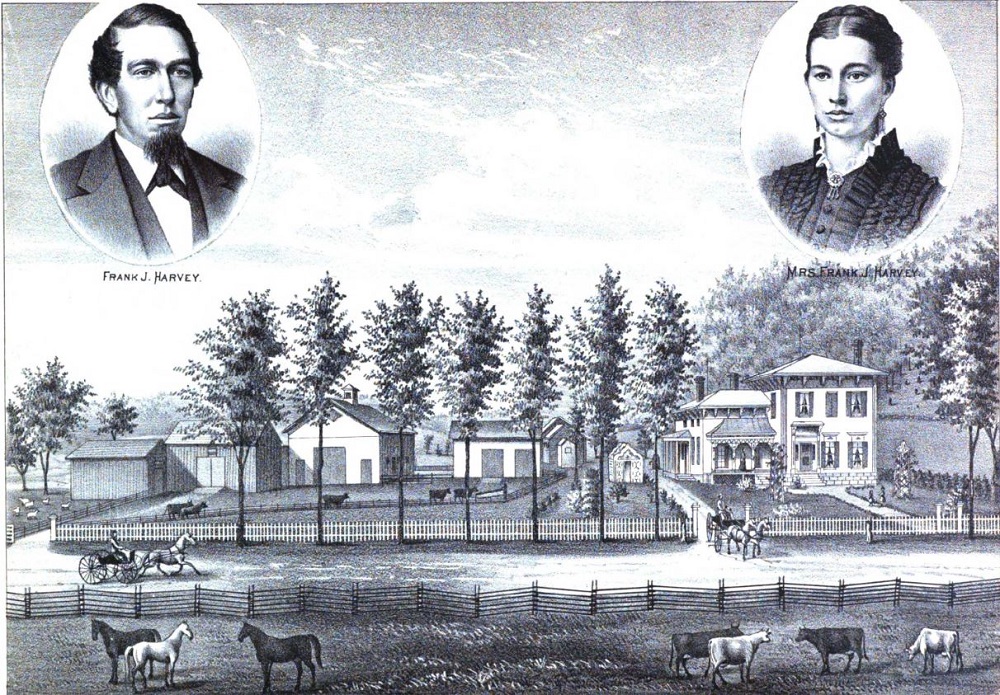 |
| HISTORY OF CATTARAUGUS COUNTY, NEW YORK |
289 |
|
C. B. Allen came from Gowanda to Waverly in 1833. He opened a store, now occupied as a dwelling, near the Wilber Hotel, and entered into the manufacture of pearl-ash. He built an ashery in the winter of 1833-34, which is still standing on the north side of the creek. In 1840 he purchased a half-interest in the woolen-mill, and the next year the other half. He continued manufacturing until 1851, when D. T. Gibson entered into partnership, which was continued until December, 1867, when the mill was destroyed by fire. He did not again engage in the business, but sold his interest to Mr. Gibson. He represented bis town as supervisor in 1837 and 1838, and is still living in Waverly. W. H. Strickland came from Watertown in 1832, and settled 50 acres on lot 3, township 5, range 8. He was one of the constituent members of the Methodist Episcopal Church at Waverly. In 1843 he married Statira, daughter of Judge Allen, of Gowanda, and sister of C. B. Allen, of Waverly. He is still living on the farm he first settled. Sayler Ross, a native of Rhode Island, located land on lot 32, township 5, range 8, and lots 4 and 5, township 6, range 8, in 1842, and with his wife, six sons, and three daughters settled on lot 32. His sons settled near: Waldo, 125 acres on lot 3; Asa, on the old homestead; Col. C. A. Ross, near where the cheese-factory now is. Ira Root, a soldier in the war of 1812, emigrated to this town in 1832, and settled on lot 3, township 6, range 8, where his family still reside. Nicholas Ballard came in town in 1838, built the first wagon-shop in the town at Waverly, and is still living here. The present town of Otto contained as land-owners, in 1819, Wm. Cook, lot 21, Mason Hicks, lot 23, and Joseph Bartlett, lot 24, all in township 5, and 7th range; Ira Waterman, lot 1, and Ephraim Brown, on lot 6, township 5, and 8th range. From the assessment-roll of
1824, the following names are taken as land-owners at that time, and
the lots on which they located :
|
ORGANIZATION OF TOWNOtto, named in honor of Jacob S. Otto, was erected from Perrysburg by
act of Jan. 29, 1823, which provided, " that from nod after the 2nd
Monday in February next all that part of the town of Perrysburg
comprising township No. 5 in 7th and 8th ranges of Holland Land Company,
and so much of the 6th township in the 7th range and 6th township in
8th range as lays on south side of Cattaraugus Creek and east of south
branch of said creek, shall be erected into a separate town by the name
of Otto, and that the first town-meeting to be held therein shall be
held at the house of Ephraim Brown, on the second Tuesday of February
next." It embraced all the present town of Persia except that portion
lying in the 6th township, 8th range. April 12 of the same year, " all
that part of Otto lying west of the south branch of Cattaraugus Creek,
in the 5th township, 8th range, was by act, annexed to Perrysburg. The
first town-meeting was held at the time and place specified in the act,
and the organization was effected by the election of the following
officers : Abel M. Butler, Supervisor; Tyler M. Beach, Town |
|||||||||||||||||||||||||||||||||||||||||||||||||||||||||||||||||||||||||||||||||||||||||||||||||||||||||||||||||||||||||||||||||||||||||||||||||||||||||||||||||||||||||||||||||||||||||||||||||||||||||||||||||||||||||||||||||||||||||||||||||||||||||||||||||||||||||||||||||||||||||||||||||||||||||||||||||||||||||||||||||||||||||||||||||||||||||||||||||||||||||||||||||
| 290 |
HISTORY OF CATTARAUGUS COUNTY, NEW YORK |
|
|
Clerk; Ira Watem1an, Luther Town, and Asaph Silsby, Assessors; Benjamin Austin and Samuel Tuthill, Overseers of the Poor; Jabez Hull, Willis Boutwell, Harvey Butler, and Ira Waterman, Commissioners of Common Schools; Joseph Foster and Samuel Tuthill, Inspectors of Common Schools; Justus Bartholomew, Davis Benedict, and Ira Waterman, Commissioners of Highways. At this meeting it was resolved to meet at the dwellinghouse of Benjamin Ballard the first Tuesday in March. At this special meeting Joseph Allen was chosen collector, and Ichabod Harding, John Campen, Alexander Little, Luther Town, Willis Boutwell, Isaiah Truman, Horace Wells, Josiah Baker, and Elijah Parmenter were chosen overseers of districts from No. 1 to 9 respectively. It was voted that $250 be raised for highways. The following is a list of supervisors, town clerks, nod justices of the peace to the present time:
JUSTICE OF THE PEACE
The first were elected in 1827, and were classed as follows: Asahel Hill, for one year; John T. Ferris, for two years; Samuel Tuthill, for three years; Abraham L. Gibbs, for four years; Joseph Allen, Ozi M Goodale, Joseph Foster, Asa Leland, Isaac Mason, Arnold Bently, Joseph Allen, Joseph Forster, Daniel Pratt, Selleck St John, Sylvester Pierce, Hugh Orr, Asa Leland, Homer J. Wooden, E.A. Rice, Joseph Foster,Joseph Allen, John Wilcox, Selleck St. John, Philander Griffiths, Conrad Vosburg, Joseph Allen, John C. Carpenter, Selleck St. John, Samuel C. Everts, Tyler M. Beach, Joseph Foster, Orson Cochrane, Arnold Bently, Homer J. Wooden, Conrad Vosburg, Selleck St. John, George W. Harvey, Joseph Foster, Homer J. Wooden, David T. Gibson, Miles M. More, Julius B. Maltby, Philip Lake, Oliver Dake, Henry Bull, Orson Cochrane, Ralph Dewey, Walter H. Strickland, James C. Green, Philip Lake, Orson Cochrane, Ralph Dewey, George Parkinson, Albert Hemstreet, Ralph Dewey, John A. Losee, D. T. Gibson, Justus Scott, Orson Cochrane, John t. Newman, Walter H. Strickland, Orson Cochrane, Nathan Larabee, Darwin C. Babcock, David C. Gibson, Charles E. Pratt. SCHOOLS.The first settlers in Otto were in the Valley of Zoar, in 1810, and the children of these pioneers attended schools in the town of Collins, on the north side of Cattaraugus Creek. The school-house stood on a bluff. The first indication |
of a school in the town was at the first annual town-meeting, in March, 1823, when it was voted to raise by tax double the amount of the school fund appropriated by the State; and at a meeting of the commissioners of schools, convened at the house of Tyler M. Beach, March 18, 1823, it was voted to erect the following tract of land into a school district, by the name of District No. 1, comprising four tiers of lots, from the east side of township No. 5, in the 7th range. District No. 2, being four tiers of lot8 from the west side of the same township, was erected the same day, Jabez Hull and Harvey Butler, commissioners. The 19th day of March, 1823, Districts Nos. 3 and 4 were erected; May 8, 1823, Nos. 5 and 6; Sept. 13, 1823, No. 7 ; April 18, 1825, No. 8; May 13, 1825, No. 9; Oct. 21, 1825, No. 10; and Nov. 11, 1826, No. 11 were erected, these comprising the districts that are now in Otto and East Otto and part of Ashford. The first school-house was built of logs in the spring of 1823, on lot No. 14, on the farm now owned by Job Austin, and school was taught the summer of that year by Betsey Chaffee. Harvey Little was sent by his father on horseback to Springville to bring her from that place to tench the school. She married afterwards -- Eaton, of Springville, and her descendants are living in that village. In the winter of 1823-24, Edward W. Austin taught in the same place. William Farlane taught there also in the winter of 1824-25. In the spring of 1825, a school-house was built on the farm of Benjamin Austin, lot 7, now owned by Jacob Austin. Philura Beach was the teacher that summer. She afterwards married Martin Perrins, of Collins. A school-house was built the same season near Davis Benedict's. The first school taught in Wavcrly was in the log house of Stephen Rogers, built where the William T. Elliott's bank now stands, and Sydney Stearns was the teacher in the winter of 1826. The present school building in Waverly was erected in 1876, at a cost of $2200. The present number of school districts is 8, containing 8 school buildings, valued, with their sites, at $3725. Volumes in library number 187, valued at $60. Nine teachers are employed, and the amount paid for teachers' wages for year ending Sept. 30, 1878, $1673.99. The number of children of school age was 344; the average daily attendance, 153.779; the number of weeks taught, 244. The amount of public money received from the State was $919.25 ; amount of money received from tax, $952.32. These statistics are from the report made to the Hon. Neil Gilmour, superintendent of public instruction, and furnished by him CONGREGATIONAL CHURCH.The first Presbyterian minister that preached in this town was the Rev. Ira Dunning. In the summer and fall of 1828, the persons who were interested in religious matters, feeling the necessity of an organization, decided to call a meeting for that purpose. In accordance with such a notice, a meeting was held at the house of Sylvanus Parkinson, Oct. 18, 1828, for the purpose of taking into consideration the propriety of organizing a church of the Prea- |
|||||||||
| HISTORY OF CATTARAUGUS COUNTY, NEW YORK |
291 |
|
byterian order. The Rev. Wm. J. Wilcox was appointed moderator, and the meeting opened by prayer. The following persons presented themselves as candidates for the proposed church : Sylvanus Parkinson and Hannah, his wife; Peter Karger and Margaret, his wife ; Catharine Parkinson, Abagail Cox, Caroline Plumb, Rebecca Bowen, Jeremiah Spalding, and Tyler Spalding, all of whom were certified by letter as being in good and regular standing in the Presbyterian Church. Jane Cotrael, who had never professed religion, also offered herself as a candidate. After much free and mutual conversation on the subject of doctrinal and experimental religion, the above-named persons declared themselves ready and willing to receive each other in the fellowship of the gospel, and unanimously agreed to accept the articles of faith and covenant; after the reading of which, the church was constituted by prayer, under the name and title of the First Presbyterian Church of Otto. Sylvanus Parkinson and Jeremiah Spalding were unanimously elected to the office of ruling elders and deacon. Sylvanus Parkinson was chosen to represent the church at the next meeting of the Presbytery of Buffalo, and in January, 1829, it was received as a member of that body. In April, 1830, the church reported 16 members. March 29, 1834, Jeremiah Spalding, Tyler Spalding, Klijah Crowley, and Deborah, his wife, were dismissed, to unite with a church about to be organized in the east part of the town. In 1835, at a meeting of the session, it was the opinion that the articles of faith held by them were exceptionable, and it was unanimously agreed to adopt the articles of faith as recommended by the Presbytery of Buffalo to the churches under their care. In 1839 the church reported 45 members. July 19, 1858, at a meeting called for the purpose of determining whether the church should remain under the Presbyterian form of government or adopt the Congregational, it was decided, after full and free conference of the members present, to administer the government of the church for the present under the Congregational plan, while they still continue under the watch-care of the Presbytery. An Ecclesiastical Council was held with the church, Sept. 21, 1858, for the purpose of setting apart to the gospel ministry, by ordination, W. W. Norton. Pastors and delegates from the following churches assembled at the house of W. W. Norton: Presbyterian Church of Ellicottville, Rev. Chas. Jerome, Ira Norton; Congregational Church of Napoli, Rev. H. D. Sawing, S. N. Newel; Presbyterian Church of Olean, Rev. Sylvester Cowles; Congregational Church of Little Valley, Rev. C. Burgess, George R. Powers. Rev. Charles Jerome was chosen Moderator. and Rev. H. D. Sawing, Scribe. The candidate was examined, accepted, and was ordained as pastor of the church, Rev. Charles Jerome preaching the ordination sermon. Dec. 31, 1859, at a church-meeting, it was voted unanimously that the church be known hereafter as the First Congregational Church of Otto. In the spring and summer of 1861 a church edifice was erected on the spot it now occupies, at a cost of $3OOO, and was dedicated Oct. 30, 1861; the Rev. Wm. J . Reynolds, of Chautauqua Co., preaching the dedication sermon from Matt. v. 14: " Ye are the light of the world ." |
Jan. 4, 1862, it was decided to make application to the Consociation of Western New York for admission to that body, and at the next meeting, Jan. 14, 1862, the church was welcomed to all the privileges. The Rev. Wm. D. Henry, a missionary sent out to the feeble churches in Western New York, ministered to this church with the pastor, January and February, 1862, and great good was accomplished. As the result of this meeting, 53 were accepted and added to the church in March, 1862. The pastors, from 1828 to the present time, who have ministered to the church have been as follows: Rev. Wm. J. Wilcox was stated supply for half the time; for more than one year from April, 1833, and was standing moderator from the time of its organization till 1835; Rev. Daniel T. Condee, afterwards missionary to the Sandwich Islands, was stated supply to this church and East Otto for one year from October, 1835. He was succeeded by the Rev. Sylvester Cowles, who supplied the church until 1839, when the Rev. Miles Doolittle became his successor, and ministered to the two churches for three years, when the Rev. Aaron Van Wormer assumed the pastoral care. Again, in 1845, the Rev. M. Doolittle returned to the care of the church, after which were the Revs. Royal Twitchell, S. J . Orton, Josiah Baldwin, W. W. Norton, E. C. Hall, H. M. Hickey, F. P. Tompkins, and W. D. Williams, who is the present pastor. The church numbers at present 73 members, having a Sunday-school of 90 pupils. H. S. Cotrael, Superintendent. Their house of worship was repaired in 1873, at a cost of about $1000; they also have a parsonage in connection The society is free from debt, and in good healthy condition. METHODIST CHURCHES OF OTTO.The first minister of this denomination who preached in this section, was John Griffith, and a class was organized at the house of Caleb Lewis, composed of Caleb Lewis and wife, Daniel Botsford and wife, Adam Ballard and wife, and Humphrey Ingram, with Daniel Botsford as first leader. This class was at that time on the Boston Circuit, then embracing the most of Cattaraugus County, Loring Grant, presiding elder. The church was organized in 1826, very soon after the class", and Jehial Lamb, and Joseph Foster, and Charles H. Morris were members of the first society. The ministers in charge at the organization were John Wiley and Wilber Hoag, and they were the first pastors. Services were held at the houses of the members, and sometimes in barns, until 1836, when the first church was built on the spot where the present church of North Otto stands. In 1832, the first quarterly-meeting was held in a barn belonging to Luther Sprague; Rev. Micah Segur was presiding elder. A new church was built in 1870, at a cost of $2000, and dedicated in October of that year by the Rev. C. D. Burlingame. In the fall of 1836, a new class was formed at Waverly from the mother church by Garrison Ballard and wife, W. H. Strickland, and Mrs. Burroughs. The first meetings were held at the school-house on Thomas Rogers' land, under the charge of the Rev. Ira Bronson. A church was erected by this branch in 1845, on its present site, at a cost of $5000. The ministers, as |
|
| 292 |
HISTORY OF CATTARAUGUS COUNTY, NEW YORK |
|
|
far as can be ascertained since the organization of the church, are as follows: John Wiley, Wilber Hoag, Ira Bronson, Coburn, Heywood, Cook, Davis, Kennard, Kent, Buck, Packard, H. Butlin, F. W. Conable, Blake, O. N. Roberts, F. D. Sargent, C. D. Rowley, F. D. Goodrich, and J. E. Clayton, who is the present pastor. These churches are under the same charge, and number 187 members. The Sunday-school of North Otto contains 100 scholars; William Bull, superintendent. The one at Waverly contains 56 scholars; Ralph Dewey, superintendent. There is also in connection and under the charge of these churches, a Sunday-school at East Mansfield, with 100 pupils ; Frank Keeler of this town is the superintendent. The society is in good condition, and entirely free from debt. GERMAN EVANGELICAL LUTHERAN CHURCH.This church was organized the 14th day of November, 1875, at the Masonic Hall, with 64 members. The minister in charge was the Rev. Mr. Hyer, from Missouri. A church edifice was erected in 1875-76, and dedicated Nov. 12, 1876, the services being conducted in German by the Rev. A. Z. Groszberger, assisted by the Rev. J. Bernrauther of Olean. On Monday, November 13, services were conducted in English by the pastor, Rev. C. F. Boezh. The present membership is 35, and the trustees are Lewis Miller, Frederick Beaver, and Henry Gold. BAPTIST CHURCH IN OTTO.The Second Baptist Church in Otto was organized in December, 1831, with 18 members, and services were held in school-houses. The Rev. A. Wells was the first pastor in 1833, ministering half the time. The church was received in the Association in 1833, reporting at that time 47 members. The pastors succeeding Mr. Wells were the Revs. D. Platt, L. Wall, and D. Platt. In 1839, they reported 57 members. No reports were made to the Association after this year, and the society has become disorganized. No church edifice was erected. THE CLINTON F. PAGE LODGE, NO. 620, F. AND A. M., was constituted at Otto, June 15, 1867, by the Grand Lodge of the State of New York, with Ralph Dewey as Master, and Phipps Lake as Senior Warden. The Past Masters have been Ralph Dewey, Frank Elliot, Phipps Lake, T. B. Gibson, and John T. Newman. The present officers are T. W. Gibson. W. M.; W. Pflueger, S. W.; Frank Barber, J. W.; M. S. Botsford, Treas.; Ralph Dewey, Sec. Masonic Hall building is owned by the society, the upper story of which is devoted to their use. They number at present 70 members.OTTO LODOE, NO. 386, I. O. OF O. F.,was constituted by the Grand Lodge of the State of New York, Aug. 22, 1848, with G. S. Gowdy, N. G.; Pliny L. Fox, V. G.; E. C. Eddy, Treas.,and W. H. Eddy, Sec. Besides the charter-members, four were admitted by card and twelve were initiated the first night of meeting. The Grand Lodge took up the old charter, issuing a new one, under the name and title of Otto Lodge, No. l37, Dec. l, |
OTTO GRANGE, NO. 381, PATRONS OF HUSBANDRY,is in the northwest part of the town. The meetings are held at the Dake school-house. They number 27 members. CEMETERIES.Waverly Burying-Ground Association is situated on the hill east of the village, adjoining the Congregational church, and contains about three acres. It is incorporated, and the officers are C. B. Allen, Pres.; W. F. Elliot, Treas.; W. E. Hunt, Sec. A burial-ground is in the north part of the town, near the Methodist church, and is known as the Benedict Burying- Ground. It is still in use. WAVERLYwas first settled by C. B. Parkinson, Stephen Rogers, and others, the first in 1822. It is situated in the center of the southern part of the town, near the boundary line, and in a deep valley of the south branch of Cattaraugus Creek. The business portion of the village is in the valley, and the residences are mostly upon the slopes and the plateau upon the hill to the east. The south branch of the Cattaraugus Creek at this place was dammed as early as 1822, and the saw-mills and grist-mills that were erected have long since passed away, but the water privileges are still utilized. D.M. Brown has a flouring-mill, known as the "Otto Mills," in successful operation, having three run of stone. This mill was built in 1860, and passed to its present ownership in 1871. A saw-mill is situated above the bridge, and has connected with it a cider-mill. Down the stream is located the iron-foundry and machine-shop of R. Dewey. The present building was erected in 1877, the old one having been destroyed by fire. About a quarter of a mile farther down the stream stand the Pearce Woolen-Mills, having 750 spindles and 2 full seta of machinery, which are in successful operation. The first mill erected here was in 1829, by Roswell Knowlton, as a custom-mill. In 1839, machinery was added for the manufacture of woolen goods, the most of the time under the firm of Allen & Gibson, until 1867, when the buildings were destroyed by fire. They were re-erected by D. T. Gibson, and are now owned by Charles B. Pearce. A cheese-factory, owned by persons in New York City and Herkimer County, under the name of the American Association, is located on the creek, at the village, and manufactures the milk of 300 cows. In March, 1867, Cox, Elliot & Co. opened a private bank in the village of Waverly. In 1869, Mr. Cox retired, and the business was conducted by W. F. Elliot & Son, until 1874, since which time it has been conducted entirely by W. F. Elliot. Besides these the village contains 2 hotels, 2 churches, school-house, post-office, 3 dry-goods and grocery stores, 2 groceries, tobacco and cigar-store, 2 drug-stores, jeweler, hardware-store, merchant-tailor, market, boot and shoe-store, harness-shop, cabinet shop, 3 blacksmith-shops, 2 carriage shops, photograph-gallery, millinery-store, manufacturer of oils, 1 lawyer, and 3 physicians. |
|
HON. S. V. POOL
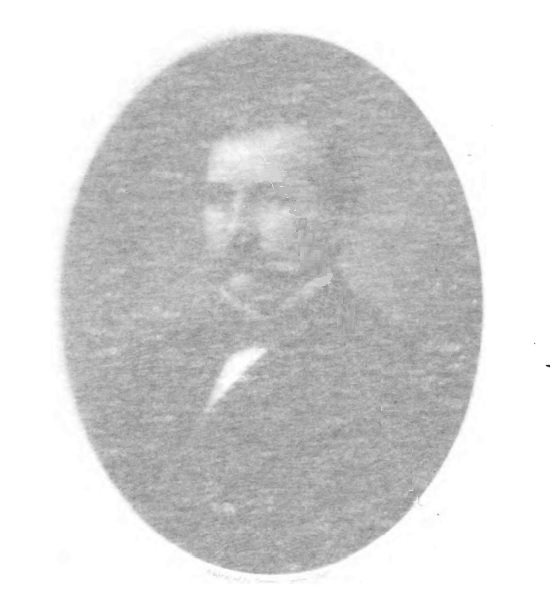 |
| HISTORY OF CATTARAUGUS COUNTY, NEW YORK |
293 |
| 294 |
HISTORY OF CATTARAUGUS COUNTY, NEW YORK |
|
|
an honorable record, but having experienced a most eventful one. Participating in the battles of Chancellorsville and Gettysburg, in the latter engagement he was taken prisoner, and endured the tortures of Libby and other Southern prison-pens for twenty months. While confined in the rebel prison at Charlotte, N. C., he effected his escape, Feb. 17, 1865, by running the guard, in attempting which many others had been shot. For four weeks he was a fugitive within the enemy's lines, skulking wearily along unfrequented paths by night, and hiding in the woods and marshes during the day; wandering over to him unknown roads, crossing and re-crossing the Blue Ridge Mountains several times, only to find himself as far from liberty as before, and receiving his nourishment chiefly at the hands of friendly negroes and sympathizing "crackers." After a walk of four hundred miles, on the 16th of March he found himself, to his unbounded joy, in the vicinage of a Union camp, and entered the Federal lines at French Broad River, eighty miles above Knoxville. During his journey, before reaching the mountains, he came to the Catawba River in the night time, to cross which he stripped off his clothes and tied them on the back of his head, expecting to have to swim, but the water was too shallow, and he waded across. Upon reaching the Union army, he went immediately to Washington and reported for duty. Politically, Dr. Pool has always been a Republican. He has served as supervisor of Otto for three years, and in the fall of 1877 was elected to the State Legislature, assemblyman for the Second District of this county, by a handsome majority over Charles E. Gallagher, the Democratic candidate. In the State Legislature he served as a member of the committee on public health, ·and as chairman of the committee on Indian affairs. He was re-elected in 1878. Although bred to the profession of medicine, he has shown marked ability as a legislator, and were he ambitious of political honors, could have almost any office at the gift of his fellow-townsmen, so greatly esteemed is he in his town and vicinity. But he prefers the duties of his profession. Dr. Pool is deservedly popular wherever known, whether in the sick-room or in legislative halls. He possesses the necessary qualifications of the successful physician,-knowledge, geniality of disposition, and firmness, blended with compassionate kindness. ORSON COCHRANwas born in Springville, Erie Co., N. Y., Jan. 26, 1815, and was the oldest son and the fourth child in a family of four girls and five boys. The second son, I. G. Cochran, was born Feb. 5, 1817, and was sent to Persia, in Asia, by the Presbyterian Missionary Society, in 1847, and died there in 1870 ; the third son is living on the old homestead at Springville; the fourth son, A. G. Cochran, is living in Great Valley, Cattaraugus Co.; the fifth son and youngest child was principal of the State Normal School at Albany, N. Y., for a number of years, and is now President of the Polytechnic Institute at Brooklyn, N. Y. Orson Cochran, being the oldest son, was kept at home to work on the farm and wait on travelers. He was sent to a common school, summer and winter terms, until eleven |
years of age, then three months in the winter until fourteen. He subsequently attended the Springville Academy three terms, and taught school three winters. He commenced surveying land and roads in t.he spring of 1831. and did all of the surveying of roads in the town of Ashford, Cattaraugus Co., for several years. In 1833 he ran the first road up the Thatcher Brook from Gowanda to
Dayton Summit, and surveyed several farms there; it was then almost a wilderness. He was married to Adaline A. Angle, Dec. 15, 1836, who was born at Glen Falls, N. Y., Nov. 22, 1817; she was the daughter of William Angle, of Amsterdam, Holland, and Margaret (Sullivan) Angle. In 1837 they commenced keeping house three miles west of Springville; cleared up fifteen acres of wild land, sold out in 1839, and moved into Otto in April, 1840. He was elected justice of the peace in 1850, to fill a vacancy, and has served seven full terms since. He was elected town superintendent of common schools in 1853, and served until the office was abolished. His family consisted of six children,-Samuel D., born Nov. 4, 1838, graduated at the State Normal School in 1860, and taught school five years as principal of a high school in Mamaroneek, Westchester Co., N. Y.; died Sept. 4, 1865. Catharine H., born Dec. 26, 1840; married L. R. Newman, Feb. 5, 1862; died Oct. 26, 1865. William II., born Jan. 25, 1843; enlisted, in September, 1861, in the Ellsworth Regiment for three years; wounded at Fredericksburg by a ball through the foot. As soon as able, he was put into the commissary department as clerk, and remained in the war office until 1866. He then resigned his post and went to Grand Rapids, Wis., where he is now the cashier of the First National Bank of that place. Joseph Wilbur, born April 8, 1845; enlisted in the army in 1863, and served until the close of the Rebellion ; studied law for a profession, and is now a practicing attorney in Grand Rapids, Wis. Emma F., born Aug. 12, 1852; married, .Jan. 22, I8n, to George C. Dewey; resides in Otto, Cattaraugus Co., N. Y. Anna F., born Oct. 21, 1855; mar- |
||
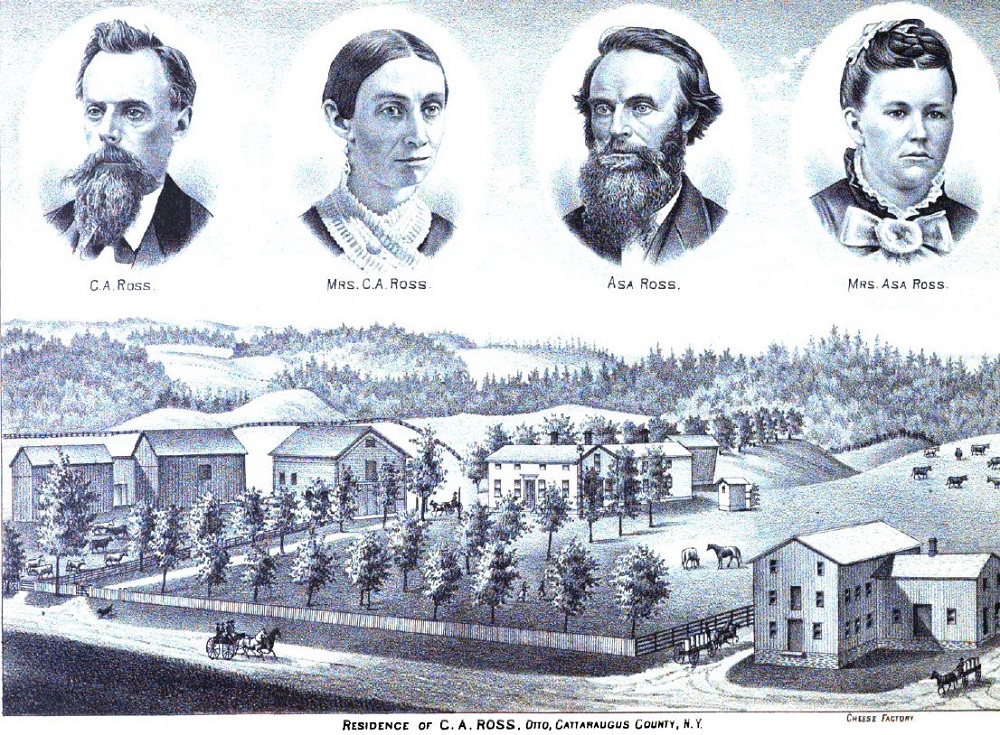
SAYLES ROSS
|
Sayles Ross was born in the town of Gloucester, R. I., April 24, 1792. At the age of seventeen he removed with his father to Broome Co., N. Y., his mother having died some years before. His father being a poor man and unable to do much for his children, young Rosa's educational advantages were extremely limited,- three months' schooling was the extent of his privileges in this direction. Broome was then a new country, and his principal occupation was wood chopping, which he followed aft.er coming to Cattaraugus County in 1827, where he "articled" fifty acres of land in the northwestern part ofthe town of Perrysburg fifty acres of land in the northwestern part of the town of Perrysburg Mr. Ross removed to the town of Otto in 1843, locating on the fam1s now occupied by his sons, Asa and Ambrose. He married, in 1817, Mehitabel
Cutler, daughter of Francis Cutler, of Broome Co., N. Y. She was born
April 26, 1797, in Plainfield, N. H. Their family of nine children, six
sons and three daughters, was as follows : Caroline, Reuben, Ira, Asa,
Colonel Ambrose, Amanda, Waldo Green, and Charlotte Rutilla, of whom all
are living, except Mrs. Amanda Green (wife of Jas. H. Green, of Otto),
who died May 16, 1867. All of the |
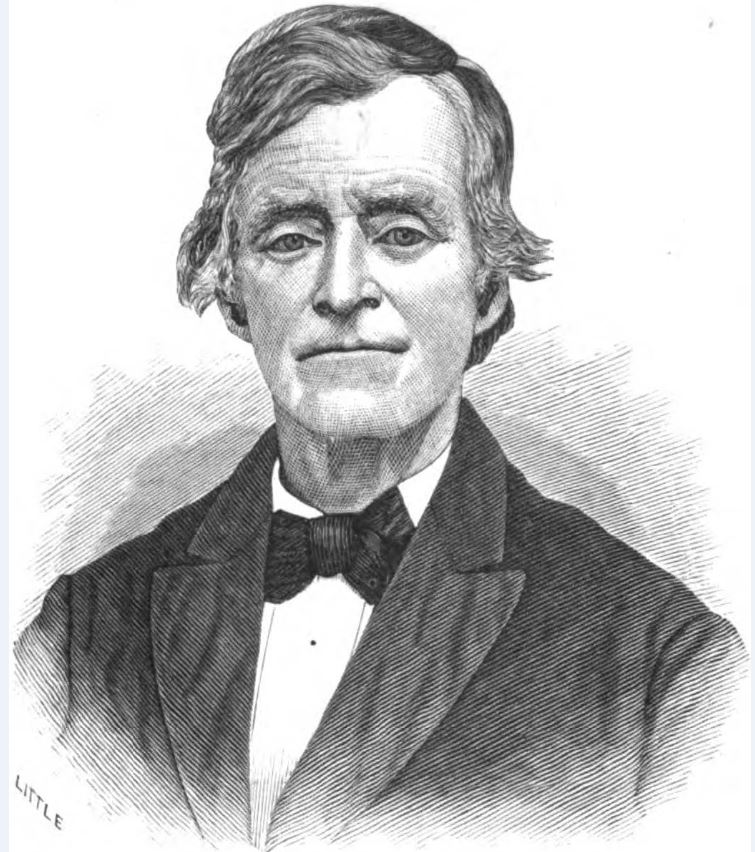 | children attained to years· of manhood and womanhood, and allsave one (Caroline, living in Dunn Co., Wis.) located on farms in the neighborhood of each other. Ira resides in Erie County, and Reuben in the town of Persia, this county ; all the rest reside in Otto. Sayles. Ross departed this life Feb. 2, 1871 ; his wife passed from earth in the year 1865. Both died in Otto, and were buried on the homestead farm, in accordance with their previous expressed wishes in that regard. Asa and Ambrose reside on the old home farm, a view of which, together with their portraits, is given herewith The first cheese-factory operated by Asa and C. A. Ross wa1.1 started in 1872, since which they have purchased two others, located on the main road from Waverly to Zoar. They are very extensive operators in this branch of business, and active, enterprising men Asa Ross was elected supervisor for the town of Otto, in 1878, upon the Democratic ticket. His election in a strongly Republican town attests his popularity with his fellow townsmen. Successful, well-to-do men are both of the brothers, and highly esteemed by all. | |
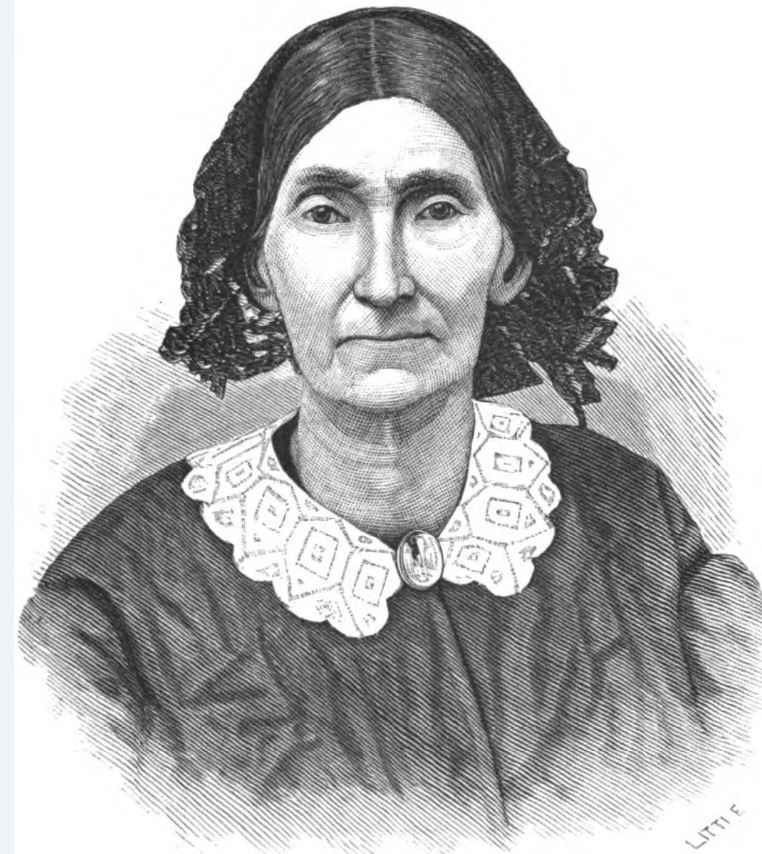 Mrs. Sayles Ross
|
|||
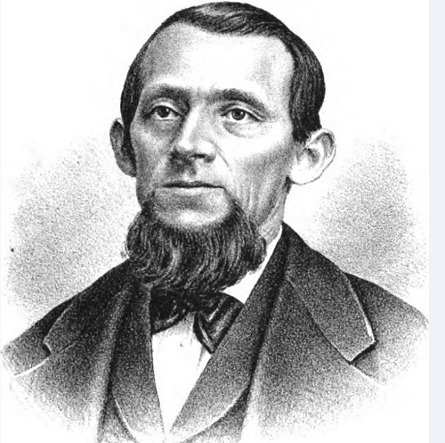 |
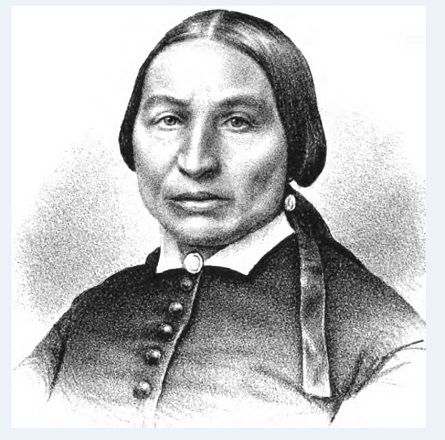 |
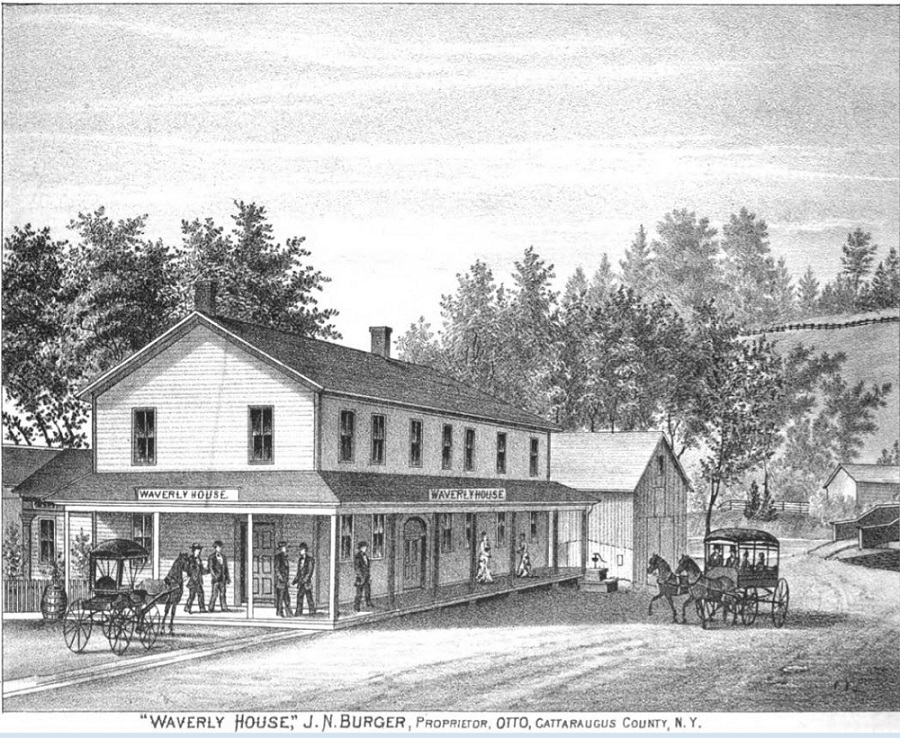 |
|
| HISTORY OF CATTARAUGUS COUNTY, NEW YORK |
295 |
|
ried, Aug. 1, 1871, to Benjamin I. Slingerland, and resides in Otto, Cattaraugus Co., N. Y. Samuel Cochran, the father of the above, was born in the State of Vermont, adjoining the State of Massachusetts, in the valley of the Connecticut River, Jan. 21, 1785; married Catharine Gallup, Nov. 6, 1805. Catharine Gallup was born Feb. 22, 1787, in the State of Massachusetts, adjoining Vermont. When married, they moved to Painted Post, Tioga Co., N. Y., and moved from there, in the winter of 1809, to Springville, Erie Co., N. Y., where he purchased a form of one hundred and seventy-five acres. In 1824 he put up a tavern sign, and kept a public-house from that time until his death, in 1846. JOHN NICHOLAS BURGERwas born Oct. 17, 1826, at Weitmes, State of Oberfrankcn, Kingdom of Bavaria, of which place his father, Johannes Burger, was a native, and where he taught school for over forty years. His mother, whose maiden name was Elizabeth Degelman, was a native of the town of Drothenreth, in Bavaria. John N. Burger, after fulfilling the requirements of the law in regard to service in the army, emigrated to America in the year 1852, landing in New York City the 14th of June. He went directly to Buffalo, and from thence to Springville, Erie Co., where for four months he labored upon a farm. The following fall (Nov. 28, 1852) he went to Ellicottville, at which place he resided for four years. Before leaving his native country he had learned and followed for fourteen years the trade of a weaver; but in Western New York he found no opportunities for employ- |
ment in that branch; he therefore, upon his arrival in this county, decided to learn some trade which would be likely to be of practical benefit to him in his new home. He served an apprenticeship to the cabinet-makers' trade, at Ellicottville, which he followed for the ensuing twelve years. He removed to Otto in 1856, which has since been his residence. During the twenty-two years he has been a resident of this town, he has been variously engaged,-for eight years as a cabinet-maker, thirteen years as proprietor of a saloon and restaurant, and more recently as an innkeeper. In March, 1877, he purchased the property in Waverly village, known as the "Waverly House,"-standing on the site of the first house erected in the town,-and of which he is the present genial and successful landlord. Before leaving Germany he was married to his estimable wife (April 27, 1851), Catharine Zeitler, a native of Grafengeheig, Bavaria. To them have been born five children, - John, born June 4, 1852, who died on the Atlantic Ocean, June 11, and was buried at sea; Louisa, born Oct. 27, 1855, died Jan. 8, 1863; Annetta, born Nov. 26, 1857, died Jan. 17, 1863; Frank, born Sept. 6, 1863; and Alexander, born Feb. 8, 1865. The two last named are living at home with their parents. The father and mother of Mr. Burger are both deceased, having died in Bavaria, in the years 1844 and 1859, respectively. Of nine brothers, sons of Johannes Burger, only three came to America,-John, the subject of this sketch; Conrad, who emigrated in 1854, and who resides with his brother John; and Andrew, who came in 1849, and is a furniture-dealer in Waverly. They all reside in Otto, where Andrew and Conrad settled a few years after their brother John located in the town. |
|
